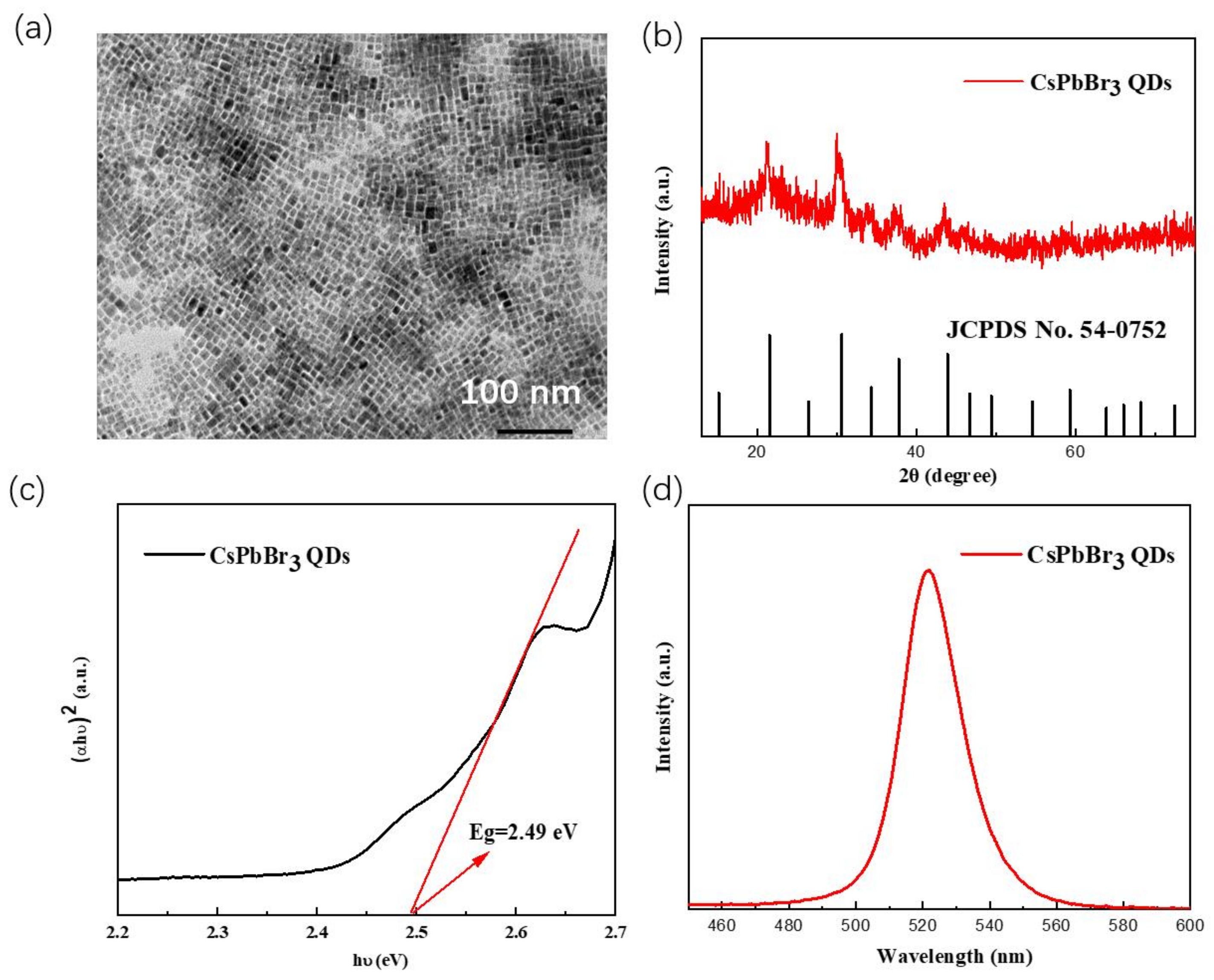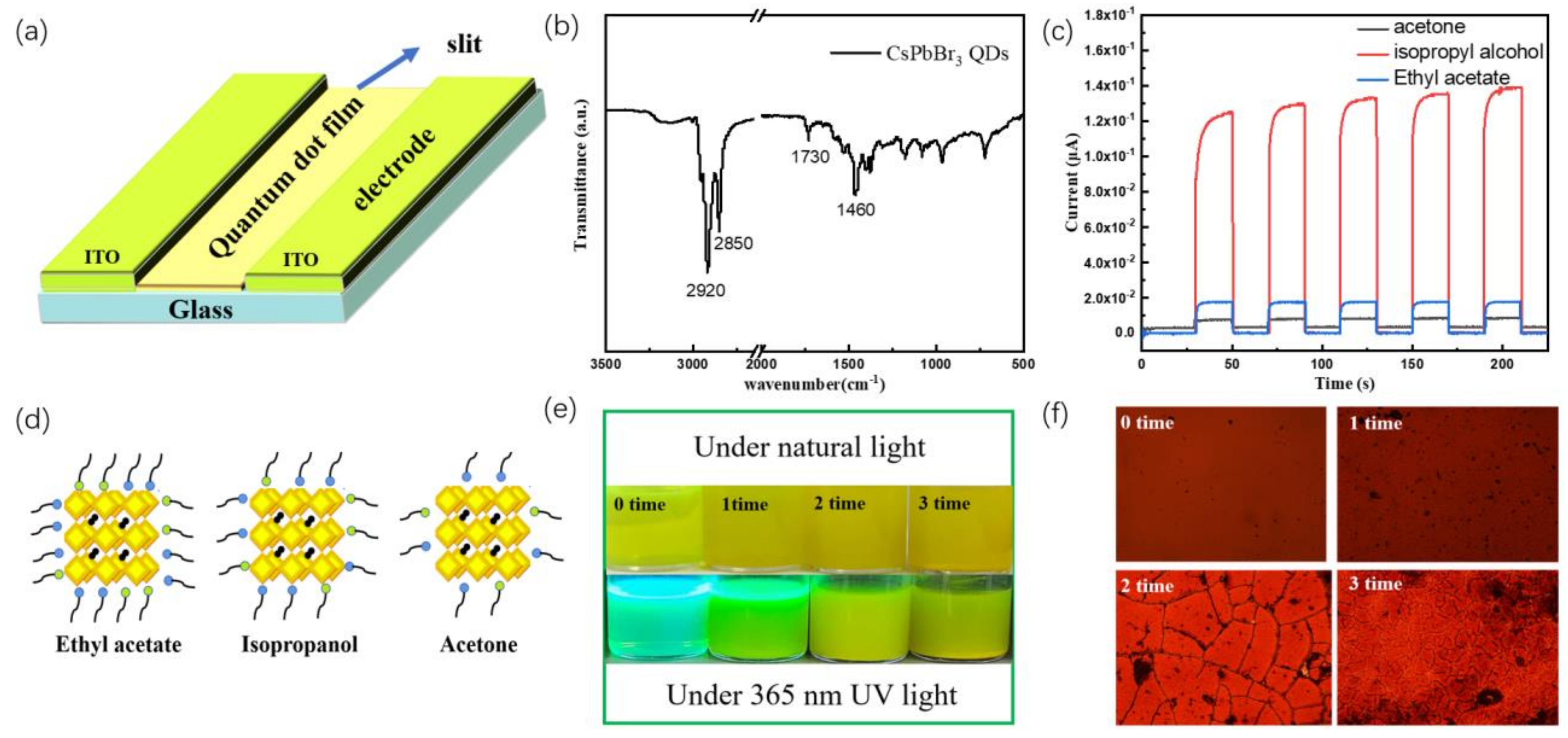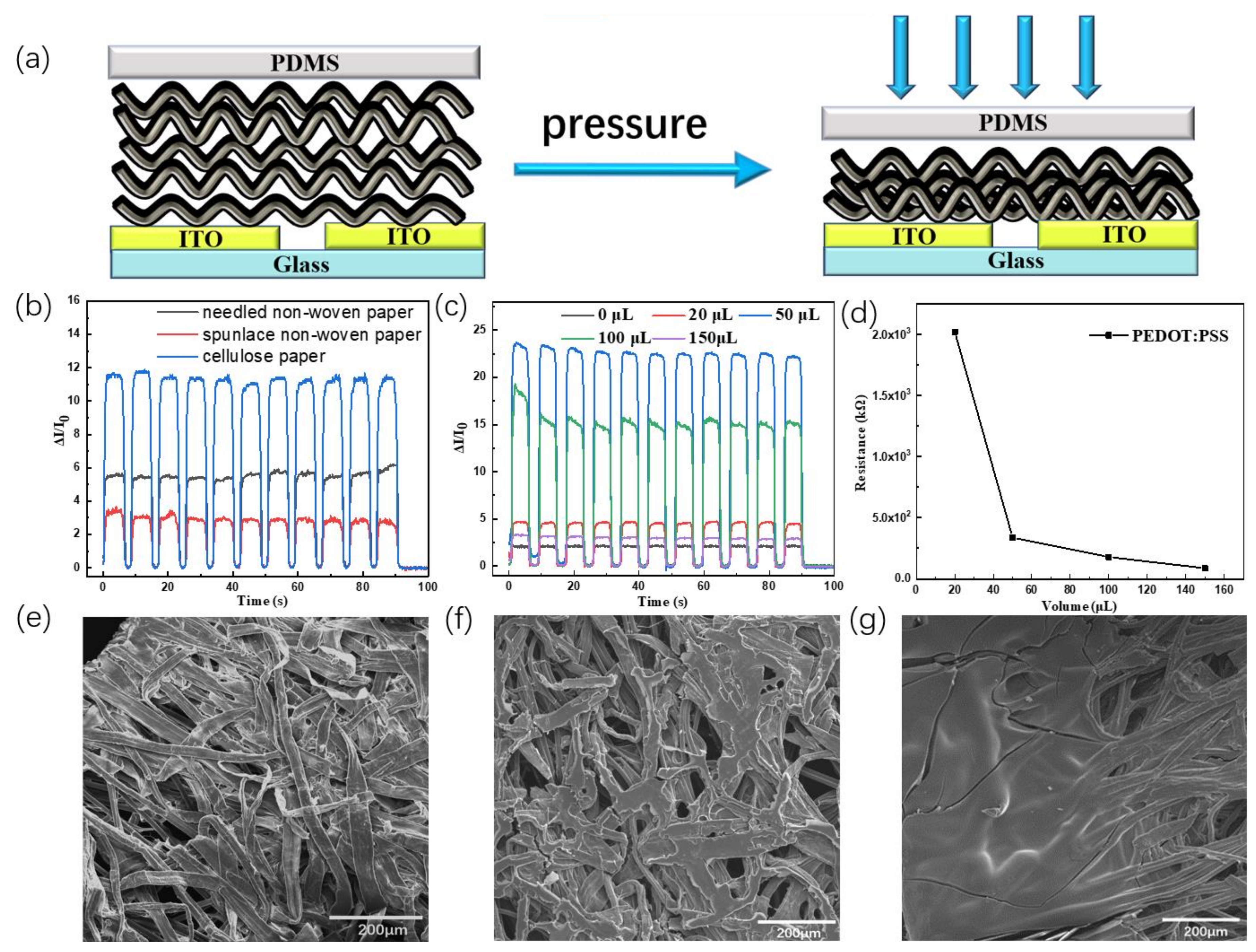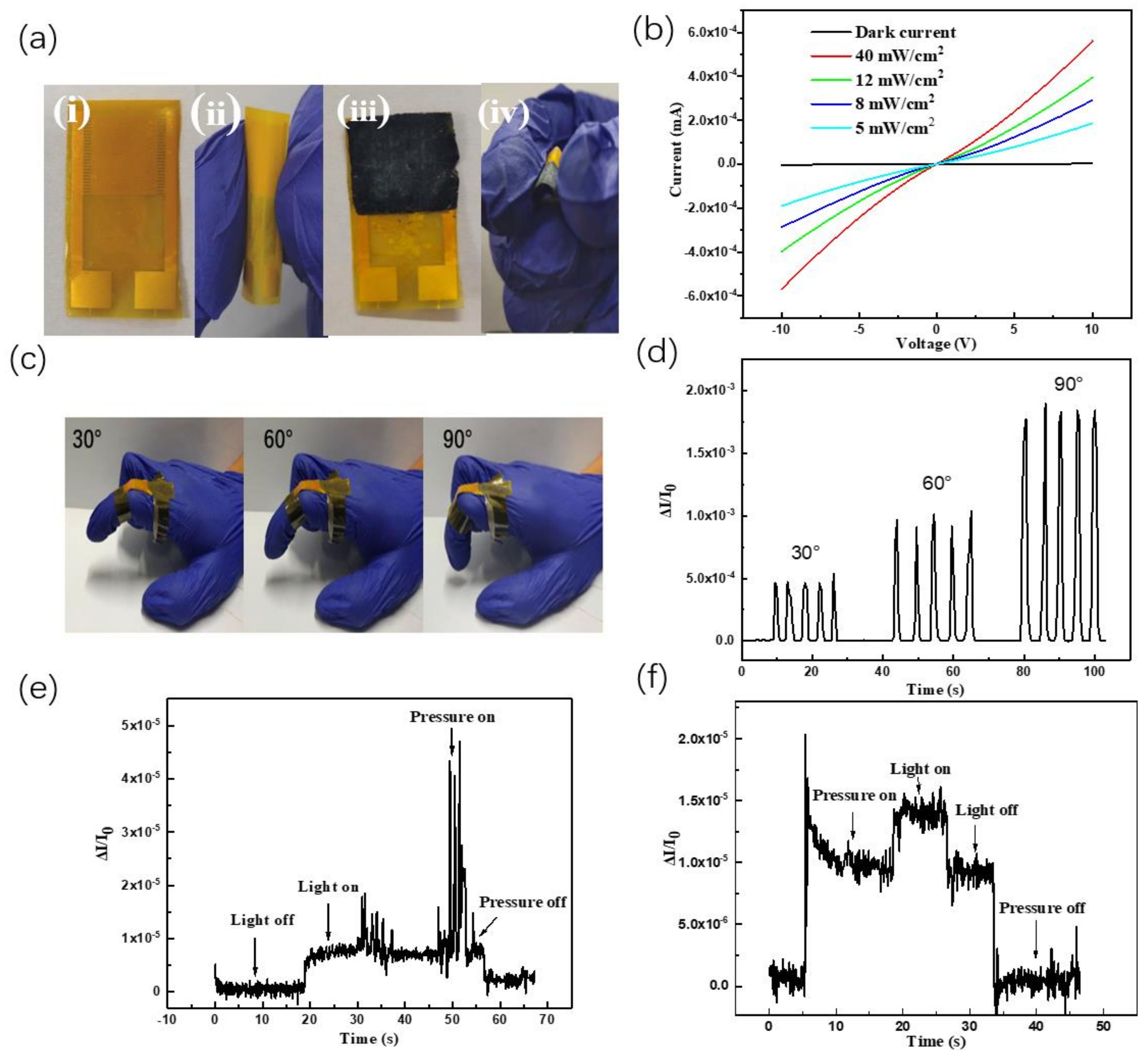A Light/Pressure Bifunctional Electronic Skin Based on a Bilayer Structure of PEDOT:PSS-Coated Cellulose Paper/CsPbBr3 QDs Film
Abstract
1. Introduction
2. Materials, Methods, and Characterization
2.1. Materials
2.2. Methods
2.2.1. Synthesis of CsPbBr3 PQDs
2.2.2. Preparation of Photodetectors Based on CsPbBr3 QDs Film
2.2.3. Preparation of Pressure Sensors Based on PEDOT: PSS-Coated Cellulose Paper
2.2.4. Preparation of Light/Pressure Bifunctional Sensors
2.3. Characterization
3. Results and Discussion
3.1. Preparation and Properties of PQDs Photodetector
3.2. Study on the Performance of Paper Based Pressure Sensor
3.3. Study on the Performance of Perovskite QDs Dual-Function Sensor
3.4. Application Research of Flexible Dual-Function Sensor
4. Conclusions
Supplementary Materials
Author Contributions
Funding
Institutional Review Board Statement
Informed Consent Statement
Data Availability Statement
Conflicts of Interest
References
- Schwartz, G.; Tee, B.C.; Mei, J.; Appleton, A.L.; Kim, D.H.; Wang, H.; Bao, Z. Flexible Polymer Transistors with High Pressure Sensitivity for Application in Electronic Skin and Health Monitoring. Nat. Commun. 2013, 4, 1859. [Google Scholar] [CrossRef]
- Cao, J.; Lu, C.; Zhuang, J.; Liu, M.; Zhang, X.; Yu, Y.; Tao, Q. Multiple Hydrogen Bonding Enables the Self-healing of Sensors for Human-Machine Interactions. Angew. Chem. Int. Ed. 2017, 56, 8795–8800. [Google Scholar] [CrossRef]
- Byun, J.; Lee, Y.; Yoon, J.; Lee, B.; Oh, E.; Chung, S.; Lee, T.; Cho, K.-J.; Kim, J.; Hong, Y. Electronic Skins for Soft, Compact, Reversible Assembly of Wirelessly Activated Fully Soft Robots. Sci. Robot. 2018, 3, eaas9020. [Google Scholar] [CrossRef]
- Liu, G.; Tan, Q.; Kou, H.; Zhang, L.; Wang, J.; Lv, W.; Dong, H.; Xiong, J. A Flexible Temperature Sensor Based on Reduced Graphene Oxide for Robot Skin Used in Internet of Things. Sensors 2018, 18, 1400. [Google Scholar] [CrossRef]
- Tee, B.C.-K.; Chortos, A.; Berndt, A.; Nguyen, A.K.; Tom, A.; McGuire, A.; Lin, Z.C.; Tien, K.; Bae, W.-G.; Wang, H.; et al. A Skin-inspired Organic Digital Mechanoreceptor. Science 2015, 350d, 313–316. [Google Scholar] [CrossRef]
- Fastier-Wooller, J.W.; Dinh, T.; Tran, C.D.; Tran, C.-D.; Dao, D.V. Pressure and Temperature Sensitive E-skin for in situ robotic applications. Mater. Des. 2021, 208, 109886. [Google Scholar] [CrossRef]
- Takei, K.; Gao, W.; Wang, C.; Javey, A. Physical and Chemical Sensing with Electronic Skin. Proc. IEEE 2019, 107, 2155–2167. [Google Scholar] [CrossRef]
- Li, W.D.; Ke, K.; Jia, J.; Pu, J.; Zhao, X.; Bao, R.; Liu, Z.; Bai, L.; Zhang, K.; Yang, M.; et al. Recent Advances in Multiresponsive Flexible Sensors towards E-skin: A Delicate Design for Versatile Sensing. Small 2022, 18, 2103734. [Google Scholar] [CrossRef] [PubMed]
- Kim, J.N.; Shadlen, M.N. Neural Correlates of a Decision in the Dorsolateral Prefrontal Cortex of the Macaque. Nat. Neurosci. 1999, 2, 176–185. [Google Scholar] [CrossRef] [PubMed]
- Dai, Y.; Fu, Y.; Zeng, H.; Xing, L.; Zhang, Y.; Zhan, Y.; Xue, X. A Self-Powered Brain-Linked Vision Electronic-skin Based on Triboelectric-Photodetecing Pixel-Addressable Matrix for Visual-image Recognition and Behavior Intervention. Adv. Funct. Mater. 2018, 28, 1800275. [Google Scholar] [CrossRef]
- Zhang, W.; Liu, Y.; Pei, X.; Yuan, Z.; Zhang, Y.; Zhao, Z.; Hao, H.; Long, R.; Nan, L. Stretchable MoS2 Artificial Photoreceptors for E-Skin. Adv. Funct. Mater. 2021, 32, 2107524. [Google Scholar] [CrossRef]
- Vuong, V.-H.; Pammi, S.V.N.; Ippili, S.; Jella, V.; Thi, T.N.; Pasupuleti, K.S.; Kim, M.-D.; Jeong, M.J.; Jeong, J.-R.; Chang, H.S.; et al. Flexible, Stable, and Self-Powered Photodetectors Embedded with Chemical Vapor Deposited Lead-Free Bismuth Mixed Halide Perovskite Films. Chem. Eng. J. 2023, 458, 141473. [Google Scholar] [CrossRef]
- Bu, H.; He, C.; Xu, Y.; Xing, L.; Liu, X.; Ren, S.; Yi, S.; Chen, L.; Wu, H.; Zhang, G.; et al. Emerging New-Generation Detecting and Sensing of Metal Halide Perovskites. Adv. Electron. Mater. 2022, 8, 2101204. [Google Scholar] [CrossRef]
- Yan, S.; Li, Q.; Zhang, X.; Tang, S.; Lei, W.; Chen, J. A Vertical Structure Photodetector Based on All-Inorganic PQDs. J. Soc. Inf. Disp. 2020, 28, 9–15. [Google Scholar] [CrossRef]
- Ren, B.; Yuen, G.; Deng, S.; Jiang, L.; Zhou, D.; Gu, L.; Xu, P.; Zhang, M.; Fan, Z.; Yueng, F.S.Y.; et al. Multifunctional Optoelectronic Device Based on an Asymmetric Active Layer Structure. Adv. Funct. Mater. 2019, 29, 1807894. [Google Scholar] [CrossRef]
- Shi, Q.; Liu, D.; Hao, D.; Zhang, J.; Tian, L.; Xiong, L.; Huang, J. Printable, ULtralow-Power Ternary Synaptic Transistors for Multifunctional Information Processing System. Nano Energy 2021, 87, 106197. [Google Scholar] [CrossRef]
- Chen, W.; Yan, X. Progress in Achieving High-Performance Piezoresistive and Capacitive Flexible Pressure Sensors: A Review. J. Mater. Sci. Technol. 2020, 43, 175–188. [Google Scholar] [CrossRef]
- Zheng, Y.; Yin, R.; Zhao, Y.; Liu, H.; Zhang, D.; Shi, X.; Zhang, B.; Liu, C.; Shen, C. Conductive MXene/cotton Fabric Based Pressure Sensor with Both High Sensitivity and Wide Sensing Range for Human Motion Detection and E-skin. Chem. Eng. J. 2021, 420, 127720. [Google Scholar] [CrossRef]
- Bu, Y.; Shen, T.; Yang, W.; Yang, S.; Zhao, Y.; Liu, H.; Zheng, Y.; Liu, C.; Shen, C. ULtrasensitive Strain Sensor Based on Superhydrophobic Microcracked Conductive Ti3C2Tx MXene/paper for Human-Motion Monitoring and E-skin. Sci. Bull. 2021, 66, 1849–1857. [Google Scholar] [CrossRef]
- Guo, Y.; Wei, X.; Gao, S.; Yue, W.; Li, Y.; Shen, G. Recent Advances in Carbon Material-based Multifunctional Sensors and Their Applications in Electronic skin Systems. Adv. Funct. Mater. 2021, 31, 2104288. [Google Scholar] [CrossRef]
- Wang, Y.; Li, X.; Nalla, V.; Zeng, H.; Sun, H. Solution-Processed Low Threshold Vertical Cavity Surface Emitting Lasers from All-Inorganic Perovskite Nanocrystals. Adv. Funct. Mater. 2017, 27, 1605088. [Google Scholar] [CrossRef]
- Li, S.; Lei, D.; Ren, W.; Guo, X.; Wu, S.; Zhu, Y.; Rogach, A.L.; Chhowalla, M.; Jen, A.K.-Y. Water-Resistant Perovskite Nanodots Enable Robust Two-Photon Lasing in Aqueous Environment. Nat. Commun. 2020, 11, 1192. [Google Scholar] [CrossRef] [PubMed]
- Oh, J.M.; Venters, C.C.; Di, C.; Pinto, A.M.; Wan, L.; Younis, I.; Cai, Z.; Arai, C.; So, B.R.; Duan, J.; et al. U1 Snrnp Regulates Cancer Cell Migration and Invasion in Vitro. Nat. Commun. 2020, 11, 1. [Google Scholar] [CrossRef] [PubMed]
- Tyagi, P.; Arveson, S.M.; Tisdale, W.A. Colloidal Organohalide Perovskite Nanoplatelets Exhibiting Quantum Confinement. J. Phys. Chem. Lett. 2015, 6, 1911–1916. [Google Scholar] [CrossRef]
- Song, J.; Xu, L.; Li, J.; Xue, J.; Dong, Y.; Li, X.; Zeng, H. Monolayer and Few-Layer All-Inorganic Perovskites as a New Family of Two-Dimensional Semiconductors for Printable Optoelectronic Devices. Adv. Mater. 2016, 28, 4861–4869. [Google Scholar] [CrossRef]
- Wu, H.; Kang, Z.; Zhang, Z.; Si, H.; Zhang, S.; Zhang, Z.; Liao, Q.; Zhang, Y. Ligand Engineering for Improved All-inorganic Perovskite Quantum Dot-MoS2 Monolayer Mixed Dimensional Van Der Waals Phototransistor. Small Methods 2019, 3, 1900117. [Google Scholar] [CrossRef]
- Heydari Gharahcheshmeh, M.; Gleason, K.K. Recent Progress in Conjugated Conducting and Semiconducting Polymers for Energy Devices. Energies 2022, 15, 3661. [Google Scholar] [CrossRef]
- Smolin, Y.Y.; Soroush, M.; Lau, K.K.S. Influence of Ocvd Polyaniline Film Chemistry in Carbon-Based Supercapacitors. Ind. Eng. Chem. Res. 2017, 56, 6221–6228. [Google Scholar] [CrossRef]






Disclaimer/Publisher’s Note: The statements, opinions and data contained in all publications are solely those of the individual author(s) and contributor(s) and not of MDPI and/or the editor(s). MDPI and/or the editor(s) disclaim responsibility for any injury to people or property resulting from any ideas, methods, instructions or products referred to in the content. |
© 2023 by the authors. Licensee MDPI, Basel, Switzerland. This article is an open access article distributed under the terms and conditions of the Creative Commons Attribution (CC BY) license (https://creativecommons.org/licenses/by/4.0/).
Share and Cite
Li, W.; Jia, J.; Sun, X.; Hao, S.; Ye, T. A Light/Pressure Bifunctional Electronic Skin Based on a Bilayer Structure of PEDOT:PSS-Coated Cellulose Paper/CsPbBr3 QDs Film. Polymers 2023, 15, 2136. https://doi.org/10.3390/polym15092136
Li W, Jia J, Sun X, Hao S, Ye T. A Light/Pressure Bifunctional Electronic Skin Based on a Bilayer Structure of PEDOT:PSS-Coated Cellulose Paper/CsPbBr3 QDs Film. Polymers. 2023; 15(9):2136. https://doi.org/10.3390/polym15092136
Chicago/Turabian StyleLi, Wenhao, Jingyu Jia, Xiaochen Sun, Sue Hao, and Tengling Ye. 2023. "A Light/Pressure Bifunctional Electronic Skin Based on a Bilayer Structure of PEDOT:PSS-Coated Cellulose Paper/CsPbBr3 QDs Film" Polymers 15, no. 9: 2136. https://doi.org/10.3390/polym15092136
APA StyleLi, W., Jia, J., Sun, X., Hao, S., & Ye, T. (2023). A Light/Pressure Bifunctional Electronic Skin Based on a Bilayer Structure of PEDOT:PSS-Coated Cellulose Paper/CsPbBr3 QDs Film. Polymers, 15(9), 2136. https://doi.org/10.3390/polym15092136






